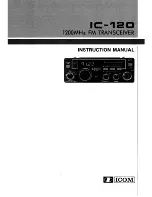
9
Circuit Description
Receive Signal Circuitry
RF Stages
Signals between 0.1 and 56 MHz received at the antenna
terminal pass through a low-pass filter, selected accord-
ing to the receiving frequency, then pass to another low-
pass filter, to remove unwanted out-of-band signals. The
filtered receiving signal passes, through one of the fol-
lowing circuits, to the 1st Mixer
Q1128
(
SPM5001
): (1)
an attenuator network (–10dB) which consists of resis-
tors R1101, R1108, R1109; (2) a “through” circuit enabled
via diodes
D1011
and
D1012
(both
DAP236U
); or (3)
RF amplifier
Q1025
(
2SC5374
).
Received 430 MHz signals, after passing through a high-
pass filter composed of L3058, L3069, C3250, C3251,
C3253, C3258, and C3298, are passed through low-pass
filter composed of L3043, L3044, C3209, C3211, C3214,
C3215, C3246, and C3255, and through a directional cou-
pler, to the UHF T/R switch circuit composed of diode
switch
D3019
/
D3022
(both
UM9957F
),
D3023
, and
D3039
(both
HSU277
). Then the signals are fed to the
1st Mixer
Q1128
via the RF-AMP
Q1026
(
2SK2685
).
Received 145 MHz signals, after passing through a high-
pass filter composed of L3055, L3056, L3067, C3248,
C3249, C3252, and C3254, are passed through a low-pass
filter composed of L3040, L3041, C3204, C3205, C3210,
C3213, and C3216, and a directional coupler, to the VHF
T/R switch circuit, composed of diode switch
D3018
/
D3021
(both
UM9957F
). Then the signals are fed to 1st
Mixer
Q1128
via the RF-AMP,
Q1024
(
BB304CDW
).
Received 76-108 MHz signals, after passing through a
high-pass filter composed of L3055, L3056, L3067,
C3248, C3249, C3252, and C3254, are passed through
low-pass filter composed of L3040, L3041, C3204, C3205,
C3210, C3213, and C3216, and a directional coupler, to
the T/R switch circuit, composed of diode switch
D3018
/
D3021
(both
UM9957F
). Then it is fed to the Wide-FM
IF IC
Q1058
(
CXA1611N
) on the MAIN Unit.
1st Mixer Circuit/1st IF Circuit
The 1st mixer on the MAIN Unit consists of quad MOS
FET
Q1128
(
SPN5001
), where the receiving signal is
mixed with the 1st local signal (68.430-538.330 MHz) from
the PLL Unit. The resulting output signal (68.33 MHz)
passes through monolithic crystal filter (MCF)
XF1001
(
MF68Q
, BW: ±6.0 kHz) to obtain the 1st IF signalwith a
center frequency of 68.33 MHz. The IF signal passes
through the 1st IF amplifier
Q1073
(
BB305CEW
) to the
2nd Mixer,
Q1083
and
Q1084
(both
2SK302Y
).
2nd Mixer Circuit/2nd IF Circuit
The 2nd Mixer consists of FETs
Q1083
and
Q1084
(both
2SK302Y
) on the MAIN Unit, where the 1st IF signal is
mixed with the 2nd local signal (67.875 MHz). The re-
sulting output signal (455 kHz) is applied to the 2nd IF
filter which is matched to the receiving mode: either
CF1004, CF1005 or an optional mechanical filter.
Noise Blanker Circuit
A portion of the 2nd IF signal is amplified by Noise
B l a n k e r A m p l i f i e r s
Q 1 0 7 5
a n d
Q 1 0 7 9
( b o t h
BB305CEW
) on the MAIN Unit, and then rectified by
D1064
(
1SS372
). This output is applied to the Noise
Blanker Controllers,
Q1093
(
2SC4154E
) and
Q1099
(
2SA1602A
), which a yield Blanking signal according
to the timing of the incoming noise pulses. Then Blank-
ing signal controls the Noise Blanker Gate
D1066
(
BAS316
), to slice out the impulse noise from the signal.
AGC Circuit
The AGC circuit consists of
D1061
(
1SS372
), transistor
Q1090
(
2SC4154E
), and associated parts on the MAIN
Unit. Output from the AGC circuit is fed back to the IF
AGC circuit that controls the gain of the IF amplifier FETs.
FM IF Circuit/FM Demodulator Circuit
On FM, the 2nd IF signal passes through the buffer am-
plifier
Q1094
(
2SC4154E
) and 2nd IF filters (
CF1002
and CF1003) to the FM IF IC
Q1080
(
TA31135FN
) which
contains a mixer, limiter amplifier, filter amplifier, squelch
trigger, and demodulator. The demodulated audio signal
at
Q1080
passes through a low-pass filter (R1339 and
C1282) and a de-emphasis circuit (R1303 and C1345),
then proceeds to the Audio Amplifier Circuit.
The squelch circuit selectively amplifies the noise com-
ponent of the demodulator output using the filter ampli-
fier inside the FM IF IC and an active band-pass filter
consisting of an externally attached resistor and capaci-
tor. Signal detection is performed by
D1057
(
DA221
).
SSB/CW Demodulator Circuit
The 2nd IF SSB/CW signal passes through buffer ampli-
fiers
Q1088
and
Q1081
(both
BB305CEW
) to the SSB
balanced demodulator
Q1071
(
SA602AD
) which pro-
duces audio by applying the carrier signal from the CAR-
DDS IC
Q1062
(
AD9835BRU
). The demodulated audio
signal is stripped of high-frequency components by an
active low-pass filter, op-amp IC
Q1120
(
NJM2902V
),
then is applied to the Audio Amplifier Circuit.
AM Demodulator Circuit
The 2nd IF AM signal passes through buffer amplifiers
Q1088
and
Q1081
(both
BB305CEW
) to the AM demodu-
lator
D1055
(
BAS316
), yielding demodulated audio sig-
nal which is applied to the Audio Amplifier Circuit.
Audio Amplifier Circuit
The demodulated audio signal is passed through AF pre-
amplifier
Q1119
(
NJM2902V
) and electronic volume con-
trol IC
Q1087
(
M62364EP
) to the AF Amplifier IC
Q1105
(
TDA2003H
) which drives the internal or external speaker
to a maximum output of approximately 2.5 Watts.
Summary of Contents for FT-857 HF
Page 4: ...4 Note...
Page 6: ...6 Note...
Page 7: ...7 Connection Diagram...
Page 8: ...8 Block Diagram...
Page 23: ...23 MAIN Unit Circuit Diagram...
Page 24: ...24 MAIN Unit Note...
Page 49: ...49 PLL Unit Circuit Diagram...
Page 55: ...55 PA Unit Circuit Diagram...
Page 56: ...56 PA Unit Note...
Page 67: ...67 PANEL Unit Circuit Diagram...
Page 81: ...81...










































